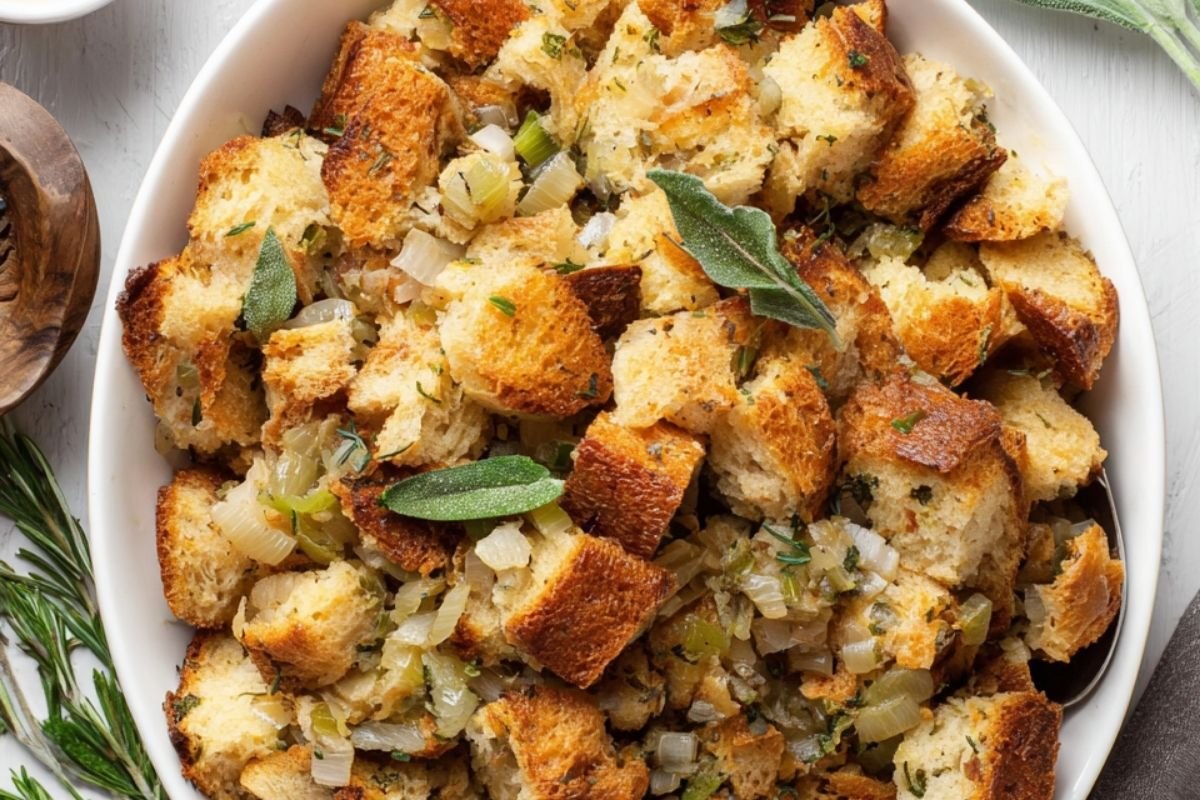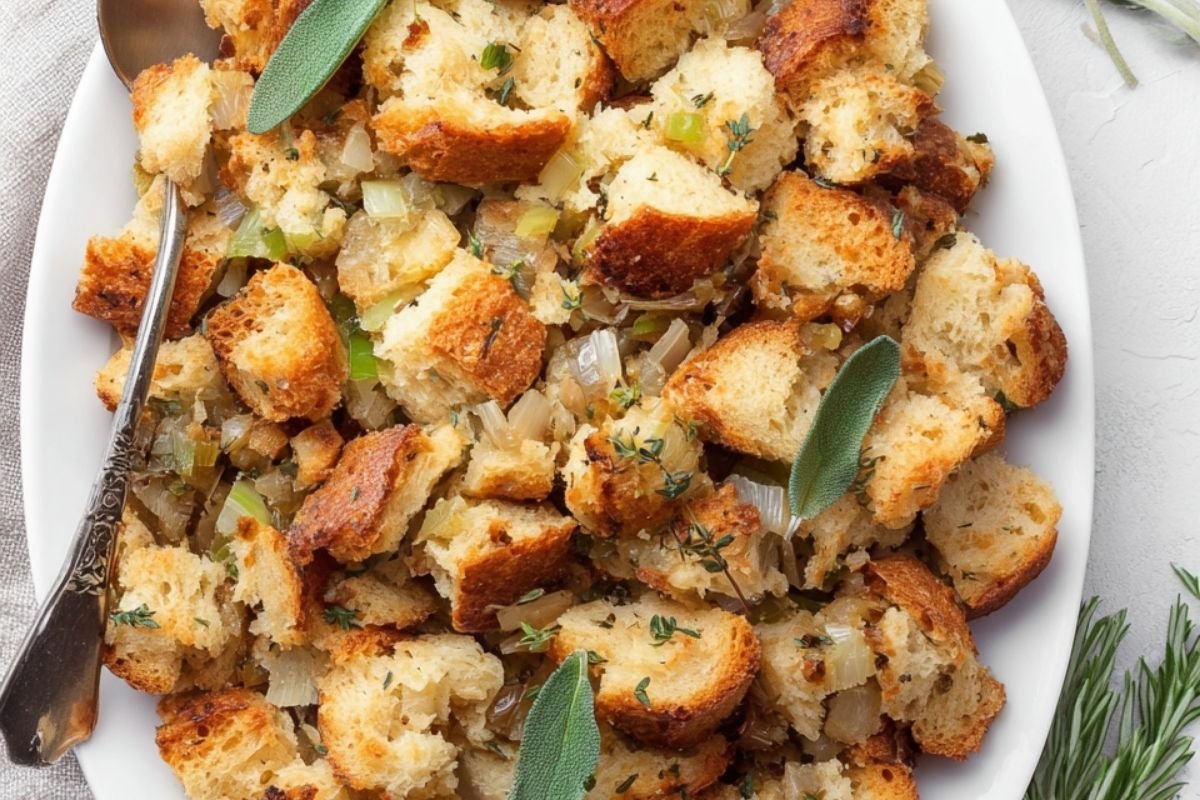When you think of holiday meals — especially Thanksgiving or Christmas — one dish rises above the rest as the cozy, fragrant, savory staple everyone loves: Classic Sage and Onion Stuffing. It’s the kind of side dish that fills the kitchen with warm, nostalgic aromas and brings people back to the table for seconds.
In this complete guide, we’re diving deep into how to make the perfect sage and onion stuffing from scratch using simple ingredients, no pork, and full, rich flavor that satisfies both traditionalists and health-conscious eaters. We’ll also cover variations, storage tips, and expert answers to common questions.
Why Classic Sage and Onion Stuffing Is a Must-Have Dish
Stuffing isn’t just a filler — it’s often the flavor backbone of a holiday meal. The soft, fluffy texture, combined with aromatic herbs like sage and the sweetness of slow-cooked onions, turns a humble bread dish into a star performer.
Here’s why this version stands out:
- No pork or alcohol — we use chicken broth and beef sausage for a clean, flavorful twist
- Budget-friendly ingredients
- Customizable for gluten-free or vegetarian needs
- Perfectly balanced herbs and moisture
- Can be made ahead and reheated without drying out
What Exactly Is Sage and Onion Stuffing?
Sage and onion stuffing is a traditional British-inspired side dish that combines stale or dried bread, sautéed onions, fresh or dried sage, and a mix of stock and fat to bind it all together. It can be baked separately in a dish or used to stuff a chicken or turkey.
Unlike stuffing mixes from a box, this homemade version has depth, texture, and rich savory notes you just can’t get from store-bought.
Ingredients for Classic Sage and Onion Stuffing (No Pork)

Here’s what you’ll need:
- 1 loaf (14–16 oz) day-old white or whole wheat bread, cubed
- 2 large yellow onions, finely chopped
- 2 tablespoons olive oil or unsalted butter
- 1 teaspoon salt
- ½ teaspoon black pepper
- 1½ tablespoons dried sage (or 2½ tbsp fresh)
- ½ teaspoon dried thyme (optional)
- 1½ cups chicken broth (low-sodium)
- 1 egg, lightly beaten (helps bind the stuffing)
- Optional: ½ pound ground beef sausage, browned and crumbled
- Optional: chopped fresh parsley for garnish
Simple pantry ingredients — but when combined, they create layers of flavor.
Step-by-Step Instructions: How to Make Sage and Onion Stuffing
Step 1: Prep the Bread
Cut your day-old bread into ½-inch cubes. If the bread isn’t stale, toast the cubes in a 300°F oven for 10–15 minutes until slightly crisp but not browned.
Step 2: Cook the Onion Base
In a large skillet over medium heat, add olive oil or butter. Sauté the chopped onions with salt, pepper, and sage for about 10–15 minutes until golden and softened. Add thyme if using.
Step 3: Add Beef Sausage (Optional)
If you’re including sausage, brown it in the skillet with the onions until fully cooked and crumbly. Use ground beef sausage as a substitute for pork.
Step 4: Combine Ingredients
In a large mixing bowl, combine the toasted bread, onion mixture, sausage, and beaten egg. Pour in the chicken broth gradually, mixing until bread is moist but not soggy.
Step 5: Bake the Stuffing
Preheat the oven to 350°F. Grease a baking dish and spread the stuffing evenly. Cover with foil and bake for 30 minutes. Then uncover and bake for another 15–20 minutes until the top is golden and crispy.
Tips for Perfect Stuffing Every Time
- Use dry bread – Moisture is key. Dry bread absorbs broth better.
- Let it rest before baking – A 15-minute rest allows flavors to meld.
- Don’t drown the stuffing – Add broth gradually.
- Bake uncovered for crispiness – The best part is the crunchy top layer.
Nutritional Benefits: Why This Stuffing Is a Smarter Choice
- No pork fat – We use lean beef sausage or keep it vegetarian
- Low sodium if using unsalted broth
- Can be made dairy-free with oil instead of butter
- Egg-free optional – Just skip the egg and press firmly when baking
On average:
- Calories per serving: ~180–220 kcal
- Protein: 5–7g
- Fiber: 2–3g
- Fat: 7–9g (lower if no sausage is used)
When to Serve Sage and Onion Stuffing
Although this dish shines at Thanksgiving, it’s equally perfect for:
- Christmas dinners
- Sunday roasts
- Potlucks
- Stuffed chicken dinners
- Midweek comfort meals
It stores and reheats like a dream, making it a meal-prep favorite.
Variations You’ll Love
Vegetarian Version
Skip the meat and add sautéed mushrooms or celery for an umami punch.
Cheesy Twist
Add shredded parmesan or cheddar before baking for richness.
Gluten-Free
Use gluten-free bread and ensure the broth is gluten-free as well.
Herbed Version
Mix in fresh rosemary or thyme for a more herbal profile.
Storage and Reheating Tips
- Refrigerate: In an airtight container for up to 4 days.
- Freeze: Wrap tightly and freeze for up to 2 months. Thaw overnight before reheating.
- Reheat: Oven method is best — 350°F for 15–20 minutes with a splash of broth for moisture.
Make-Ahead Instructions
You can fully prepare the stuffing the day before:
- Assemble everything (uncooked)
- Cover tightly and refrigerate
- Bake as instructed the next day
Pro Tip: Add a few extra tablespoons of broth before baking if it looks dry.
Serving Suggestions
This stuffing pairs beautifully with:
- Roast chicken or turkey
- Mashed potatoes and gravy
- Steamed green beans
- Caramelized carrots
- Cranberry sauce
Or enjoy on its own with a drizzle of gravy for a comfort-food snack!
FAQs: Classic Sage and Onion Stuffing
Can I stuff the turkey with this?
Yes, but always cook stuffing to 165°F internally to ensure safety.
Can I make it without eggs?
Yes. Egg helps bind, but it’s not essential. Press the stuffing firmly into the dish to help it hold.
Why is my stuffing soggy?
You may have added too much broth. Use only enough to moisten the bread — not drown it.
How do I make it more crispy?
Bake uncovered for the last 15–20 minutes. You can also broil for 2–3 minutes at the end.
What herbs work best besides sage?
Try parsley, rosemary, thyme, or a touch of nutmeg for added warmth.
Conclusion: The Comfort and Versatility of Homemade Stuffing
Classic sage and onion stuffing is one of those dishes that reminds us why simple ingredients can create unforgettable flavors. Whether you keep it traditional or add your own twist, this dish is a celebration of everything we love about home cooking: warmth, comfort, and sharing food with those we care about.
With this guide, you now have all the tools to create a version that fits your taste and your table — no pork, no wine, no fuss. Just good food made with love.
Print
Classic Sage and Onion Stuffing Recipe (No Pork) | Holiday Side Dish
Ingredients
-
1 loaf (14–16 oz) day-old white or whole wheat bread, cubed
-
2 large yellow onions, finely chopped
-
2 tablespoons olive oil or unsalted butter
-
1 teaspoon salt
-
½ teaspoon black pepper
-
1½ tablespoons dried sage (or 2½ tbsp fresh)
-
½ teaspoon dried thyme (optional)
-
1½ cups chicken broth (low-sodium)
-
1 egg, lightly beaten (helps bind the stuffing)
-
Optional: ½ pound ground beef sausage, browned and crumbled
-
Optional: chopped fresh parsley for garnish
Instructions
Cut your day-old bread into ½-inch cubes. If the bread isn’t stale, toast the cubes in a 300°F oven for 10–15 minutes until slightly crisp but not browned.
In a large skillet over medium heat, add olive oil or butter. Sauté the chopped onions with salt, pepper, and sage for about 10–15 minutes until golden and softened. Add thyme if using.
If you’re including sausage, brown it in the skillet with the onions until fully cooked and crumbly. Use ground beef sausage as a substitute for pork.
In a large mixing bowl, combine the toasted bread, onion mixture, sausage, and beaten egg. Pour in the chicken broth gradually, mixing until bread is moist but not soggy.
Preheat the oven to 350°F. Grease a baking dish and spread the stuffing evenly. Cover with foil and bake for 30 minutes. Then uncover and bake for another 15–20 minutes until the top is golden and crispy.
